Danfoss Hydraulic Pump Repair and Maintenance Guide
Danfoss Hydraulic Pump Repair and Maintenance Guide
Hydraulic pumps are the core components of hydraulic systems, and their performance stability directly affects the operating efficiency and service life of the equipment. With its excellent manufacturing process and efficient performance, Danfoss hydraulic pumps are widely used in various engineering machinery, agricultural equipment, marine and industrial automation fields. However, to ensure the hydraulic pump is stable for a long time, regular maintenance and correct repairs are crucial. This article will introduce the maintenance and maintenance guide of Danfoss hydraulic pumps to help users extend the life of the equipment and improve work efficiency.

- Daily maintenance measures Good daily maintenance is the key to ensuring efficient and stable operation of Danfoss hydraulic pump. Here are a few basic daily maintenance measures:
Regularly check the quality of hydraulic oil
The cleanliness of hydraulic oil directly affects the service life of the hydraulic pump. It is recommended to check the color, viscosity and pollution degree of hydraulic oil regularly. If the oil is found to be discolored, turbid or metal particles, it should be replaced in time.
Use hydraulic oil that meets the requirements of the Danfoss hydraulic pump 83046452 and ensure that the oil meets ISO 4406 standards to reduce wear of the parts in the pump.
Replace and clean the hydraulic filter element
The function of the hydraulic filter element is to filter out impurities in the hydraulic oil and prevent the pump body and hydraulic system from being contaminated. It is recommended to change the filter element regularly every 500 hours or according to the equipment usage to ensure the cleanliness of the hydraulic oil.
Select high-quality filter elements and ensure that their filtering accuracy meets the requirements of the equipment to improve system reliability.
Check the connection parts of the hydraulic pump
Regular inspection of JR-L-S45B-AK-15-10-NN-E-3-S1NH-A2N-NNN-JJJ-NNNN
Whether the oil inlet, oil return port and pipeline connection of the hydraulic pump is firm to avoid loosening or leakage.
Observe whether the hydraulic hose and seals are aging or damaged, and replace them in time if necessary.
Keep the temperature of the hydraulic system stable
Too high or too low temperatures will affect the working efficiency of the hydraulic pump. It is recommended to keep the operating temperature of the hydraulic system within the recommended range (usually between 40°C and 60°C) to avoid the impact of hydraulic oil on system performance due to overheating oxidation or low-temperature solidification. - Common faults and maintenance methods Even after good maintenance, some common faults may occur during long-term use of the hydraulic pump. Here are some typical failures and their solutions:
Hydraulic pump noise is too high
Cause analysis:
There is air leakage in the oil suction pipeline, causing the air to enter the hydraulic system.
Hydraulic oil has too high viscosity or serious oil contamination.
The internal parts of the hydraulic pump are worn or damaged.
Solution:
Check the suction line for leaks and make sure all pipe fittings are well sealed.
Replace hydraulic oil that meets the standards to avoid excessive viscosity or contamination.
Disassemble the hydraulic pump, check the wear of internal parts, and replace damaged parts if necessary.
Hydraulic pump pressure is insufficient or flow rate is reduced
Cause analysis:
Insufficient hydraulic oil or contamination of oil.
Variable control system failure.
Internal leakage (such as wear of plunger or dispensing disk).
Solution:
Check the fluid level of the oil tank and replenish appropriate hydraulic oil in a timely manner.
Check the adjustment status of the variable mechanism to ensure that the variable control is normal.
Remove and inspect the hydraulic pump, check whether the seals, plungers and dispensing plates are worn, and replace the parts if necessary.
A leak in the hydraulic pump
Cause analysis:
The sealing ring is aged or damaged.
The connecting parts are loose.
Cracked or damaged pump body.
Solution:
Replace aging or damaged seals.
Check and tighten all connecting parts to ensure no looseness.
If there are cracks in the pump body, it should be replaced or repaired in time. - Long-term maintenance and maintenance suggestions for hydraulic pumps. In order to further extend the service life of Danfoss hydraulic pumps, users are advised to follow the following long-term maintenance measures:
Regular equipment inspection
A comprehensive hydraulic system inspection is conducted once a month to ensure that all components are operating properly.
Professional equipment maintenance is carried out at least once a year to check the internal wear of the hydraulic pump.
Training operators
Ensure that the equipment operator has the correct knowledge of using the hydraulic system to avoid damage caused by improper operation.
Regularly train employees to improve their awareness and skills in hydraulic system maintenance.
Establish maintenance records
Record the use, maintenance and repair of hydraulic pumps in detail so that the cause of the failure can be quickly located in the event of a problem.
Record the hydraulic oil replacement time, filter element replacement time and any maintenance situation to ensure that the maintenance work is well-founded.
Conclusion JRLS45BAK1510NNE3S1NHA2NNNNJJJNNNNN
Danfoss hydraulic pumps are highly favored by users for their efficient, stable and durable characteristics, but only scientific and reasonable maintenance and timely repairs can maximize their performance and extend their service life. By regularly checking hydraulic oil, maintaining seals, replacing filter elements, controlling temperatures, and promptly detecting and repairing faults, users can ensure that the equipment is always in optimal operating conditions, improve production efficiency and reduce operating costs. Follow this guide to keep your Danfoss hydraulic pumps performing best in all operating conditions, providing continuous and stable power support for your equipment!
This article is published by the official website of Baolilai Hydraulics, please contact the author and indicate the source for reprinting:https://www.baolilai-pump.cn/news/view-3193.html


